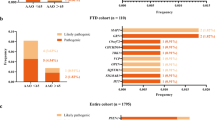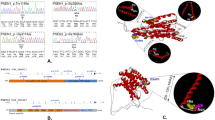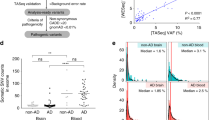Abstract
Alzheimer's disease (AD) is a disorder characterised by a progressive deterioration in memory and other cognitive functions. Neurofibrillary tangles (NFT) are a major pathological hallmark of AD, these are aggregations of paired helical filaments (PHF) comprised of the hyperphosphorylated microtubule associated protein tau. Several kinases, such as glycogen synthase kinase 3 beta (GSK3β) and c-Jun N-terminal kinase (JNK), phosphorylate tau at sites that are phosphorylated in PHF. Dishevelled 1 (DVL1) is thought to act as a positive regulator of the wnt signalling pathway, and inhibits GSK3β activity preventing β-catenin degradation and thus allowing wnt target gene expression. JNK activation is also regulated by DVL1, however it is unclear if this is via the wnt signalling pathway. These observations suggest a central role for DVL1 in tau phosphorylation and AD and led us to investigate DVL1 as a candidate gene for this disorder. We determined the genomic structure of the DVL1 gene by sequencing and data mining and searched for sequence variations in the coding sequences and flanking introns. The DVL1 gene spans a region of approximately 13.8 kb (not including the 5′ untranslated region) and is encoded by 15 exons. Analysis of over 4.3 kb of sequence, including 98% of exonic sequences and introns 2, 3, 6, 7, 9, 10, 11 and 12, revealed there to be six rare (≤6%) sequence variations. None of these had any association with late onset AD. This would suggest that polymorphic variations in the coding sequences of DVL1 are not important in AD. However further analysis of regulatory regions may lead to the identification of other sequence variations which may be implicated in AD.
This is a preview of subscription content, access via your institution
Access options
Subscribe to this journal
Receive 12 print issues and online access
$259.00 per year
only $21.58 per issue
Buy this article
- Purchase on Springer Link
- Instant access to full article PDF
Prices may be subject to local taxes which are calculated during checkout

Similar content being viewed by others
References
Clark R, Goate A . Molecular genetics of Alzheimer's disease Arch Neurol 1993 50: 1164–1172
Kanai Y, Takemura R, Oshima T, Mori H, Ihara Y, Yanagisawa M . Expression of multiple tau isoforms and microtubule bundle formation in fibroblasts transfected with a single tau cDNA J Cell Biol 1989 109: 1173–1184
Drubin DG, Kirschner MW . Tau protein function in living cells J Cell Biol 1986 103: 2739–2746
Reynolds CH, Betts JC, Blackstock WP, Nebreda AR, Anderton BH . Phosphorylation sites on tau identified by nanoelectrospray mass spectrometry: differences in vitro between the mitogen-activated protein kinases ERK2, c-Jun N-terminal kinase and P38, and glycogen synthase kinase-3beta J Neurochem 2000 74: 1587–1595
Lovestone S, Reynolds CH, Latimer D, Davis DR, Anderton BH, Gallo JM et al. Alzheimer's disease-like phosphorylation of the microtubule-associated protein tau by glycogen synthase kinase-3 in transfected mammalian cells Curr Biol 1994 4: 1077–1086
Anderton BH, Brion JP, Couck AM, Davis DR, Gallo JM, Hanger DP et al. Modulation of PHF-like tau phosphorylation in cultured neurones and transfected cells Neurobiol Aging 1995 16: 389–397 discussion 398–402
Sperber BR, Leight S, Goedert M, Lee VM . Glycogen synthase kinase-3 beta phosphorylates tau protein at multiple sites in intact cells Neurosci Lett 1995 197: 149–153
De Ferrari GV, Inestrosa NC . Wnt signaling function in Alzheimer's disease Brain Res Brain Res Rev 2000 33: 1–12
Anderton BH, Dayanandan R, Killick R, Lovestone S . Does dysregulation of the Notch and wingless/Wnt pathways underlie the pathogenesis of Alzheimer's disease? Mol Med Today 2000 6: 54–59
Li L, Yuan H, Xie W, Mao J, Caruso AM, McMahon A et al. Dishevelled proteins lead to two signaling pathways. Regulation of LEF-1 and c-Jun N-terminal kinase in mammalian cells J Biol Chem 1999 274: 129–134
Boutros M, Paricio N, Strutt DI, Mlodzik M . Dishevelled activates JNK and discriminates between JNK pathways in planar polarity and wingless signaling Cell 1998 94: 109–118
Kehoe P, Wavrant-De Vrieze F, Crook R, Wu WS, Holmans P, Fenton I et al. A full genome scan for late onset Alzheimer's disease Hum Mol Genet 1999 8: 237–245
Klingensmith J, Nusse R, Perrimon N . The Drosophila segment polarity gene dishevelled encodes a novel protein required for response to the wingless signal Genes Dev 1994 8: 118–130
Pizzuti A, Amati F, Calabrese G, Mari A, Colosimo A, Silani V et al. cDNA characterization and chromosomal mapping of two human homologues of the Drosophila dishevelled polarity gene Hum Mol Genet 1996 5: 953–958
Kishida S, Yamamoto H, Hino S, Ikeda S, Kishida M, Kikuchi A . DIX domains of Dvl and axin are necessary for protein interactions and their ability to regulate beta-catenin stability Mol Cell Biol 1999 19: 4414–4422
Bedell JA, Wagner-McPherson CB, Bengtsson U, Handa K, Dumars KW, Marsh JL et al. A 1p deletion syndrome patient is hemizygous for a human homologue of the Drosophila dishevelled gene (Abstract) Am J Hum Genet 1996 59: A298
Lijam N, Paylor R, McDonald MP, Crawley JN, Deng CX, Herrup K et al. Social interaction and sensorimotor gating abnormalities in mice lacking Dvl1 Cell 1997 90: 895–905
Wagner U, Brownless J, Irving NG, Lucas FR, Salinas PC, Miller CC . Overexpression of the mouse dishevelled-1 protein inhibits GSK-3beta-mediated phosphorylation of tau in transfected mammalian cells FEBS Lett 1997 411: 369–372
Strovel ET, Sussman DJ . Transient overexpression of murine dishevelled genes results in apoptotic cell death Exp Cell Res 1999 253: 637–648
Altschul SF, Gish W, Miller W, Myers EW, Lipman DJ . Basic local alignment search tool J Mol Biol 1990 215: 403–410
Lijam N, Sussman DJ . Organization and promoter analysis of the mouse dishevelled-1 gene Genome Res 1995 5: 116–124
Holmes C . The Camberwell Dementia Case Register Int J Geriatr Psychiatry 1996 11: 369–375
Russ C, Lovestone S, Powell JF . Identification of sequence variants and analysis of the role of the glycogen synthase kinase 3b gene and promoter in late onset Alzheimer's disease Mol Psychiatry 2001 6: 320–324
Gyapay G, Schmitt K, Fizames C, Jones H, Vega-Czarny N, Spillett D et al. A radiation hybrid map of the human genome Hum Mol Genet 1996 5: 339–346
Halushka MK, Fan JB, Bentley K, Hsie L, Shen N, Weder A et al. Patterns of single-nucleotide polymorphisms in candidate genes for blood-pressure homeostasis Nat Genet 1999 22: 239–247
Nickerson DA, Taylor SL, Weiss KM, Clark AG, Hutchinson RG, Stengard J et al. DNA sequence diversity in a 9.7-kb region of the human lipoprotein lipase gene Nat Genet 1998 19: 233–240
Cambien F, Poirier O, Nicaud V, Herrmann SM, Mallet C, Ricard S et al. Sequence diversity in 36 candidate genes for cardiovascular disorders Am J Hum Genet 1999 65: 183–191
McKhann G, Drachman D, Folstein M, Katzman R, Price D, Stadlan EM . Clinical diagnosis of Alzheimer's disease: report of the NINCDS-ADRDA Work Group under the auspices of Department of Health and Human Services Task Force on Alzheimer's Disease Neurology 1984 34: 939–944
Ewing B, Green P . Base-calling of automated sequencer traces using phred. II. Error probabilities Genome Res 1998 8: 186–194
Ewing B, Hillier L, Wendl MC, Green P . Base-calling of automated sequencer traces using phred. I. Accuracy assessment Genome Res 1998 8: 175–185
Nickerson DA, Tobe VO, Taylor SL . PolyPhred: automating the detection and genotyping of single nucleotide substitutions using fluorescence-based resequencing Nucleic Acids Res 1997 25: 2745–2751
Gordon D, Abajian C, Green P . Consed: a graphical tool for sequence finishing Genome Res 1998 8: 195–202
Terwilliger JD, Ott J . Linkage disequilibrium between alleles at marker loci. In: Terwilliger JD, Ott J (eds) Handbook of Human Genetic Linkage, 1st edn Johns Hopkins University Press: Baltimore 1994 pp 188–198
Klitz W, Stephens JC, Grote M, Carrington M . Discordant patterns of linkage disequilibrium of the peptide-transporter loci within the HLA class II region Am J Hum Genet 1995 57: 1436–1444
Lee AJ, McInerney PJ, Mullins PR . STATCALC: an integrated statistics system for the Apple II microcomputer Comput Programs Biomed 1984 18: 265–272
Acknowledgements
This study was supported by the Wellcome Trust (049542/Z). The authors wish to thank Dr Clive Holmes for the use of the clinical and genotypic data for the Camberwell Dementia Case Register. Samples from participants in the MRC trial of assessment and management of elderly people in the community (MRC Elderly Study) were collected in collaboration with the trial investigators: Professor Astrid Fletcher, London School of Hygiene & Tropical Medicine (Principal investigator) and co-investigators Dr Dee Jones, University of Wales College of Medicine and Professor Chris Bulpitt, Imperial College. We also thank Aaron Jeffries for his Unix skills.
Author information
Authors and Affiliations
Corresponding author
Rights and permissions
About this article
Cite this article
Russ, C., Lovestone, S. & Powell, J. Identification of genomic organisation, sequence variants and analysis of the role of the human dishevelled 1 gene in late onset Alzheimer's disease. Mol Psychiatry 7, 104–109 (2002). https://doi.org/10.1038/sj.mp.4000941
Received:
Revised:
Accepted:
Published:
Issue Date:
DOI: https://doi.org/10.1038/sj.mp.4000941



